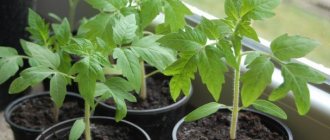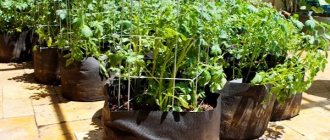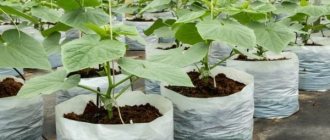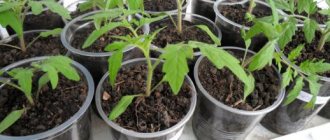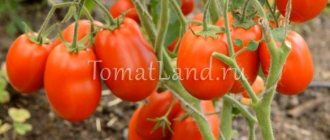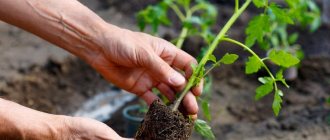So, have you finally decided to try growing tomatoes in your apartment, starting with choosing a suitable variety or hybrid? Congratulations, you are absolutely on the right track!
Well, below you will get a list of the most popular = best hybrids and varieties of tomatoes that are specifically designed (as it is written on them) for growing at home on a windowsill, balcony or loggia.
Advice! The site also has detailed material on how to properly grow tomatoes in
an apartment on a window or balcony
.
Conditions for growing tomatoes
Tomatoes on the balcony will feel good if you follow all the recommendations of experienced mini-gardeners. For tomatoes, rooms facing southeast or southwest are optimal. The south side is not the best option: you will have to provide shade here, otherwise the plants on the balcony will be hot. The north is a reason to abandon intentions, since direct sunlight is vital to this culture. In autumn and spring, additional lighting is needed, so fluorescent or phytolamps will be needed.
For tomatoes on the balcony to grow well, they need to be in the sun for at least 3 hours every day. Open balconies are a reason to protect plants from gusts of wind: pots must be placed near the walls or near the railings. If the room is glazed, then it is better to provide the tomatoes with a higher place, closer to the light. In this case, regular ventilation of the balcony is a necessity.
In addition to protection from the wind, capricious southern plants require a certain temperature regime. The ideal temperature for them is +26° during the day, +15° at night, but not lower. On closed and insulated balconies it is possible to grow vegetables all year round. The temperature on them is usually monitored with a thermometer.
Bonsai tomato variety
This is a determinate variety, the height of which does not exceed 50 cm. The vegetable crop can be successfully cultivated in flower pots or small boxes. Some summer residents have experimented with growing this plant in open beds. The variety produced a bountiful harvest. Another attractive feature of the Bonsai vegetable crop is that its fruits can not only be used for food, but also grown for decorative purposes.
Numerous positive reviews about Bonsai tomatoes are also due to other properties of the plant. These tomatoes are characterized by high yield. From each compact and low bush, without much difficulty, you can remove an average of 2 kg of ripe, juicy and very tasty fruits. Since the height of the plant does not exceed half a meter, it does not require a garter to the support.
Simple step-by-step cultivation of tomatoes on the balcony will not cause difficulties even for novice gardeners. To get a bountiful harvest, it is necessary to create an optimal level of light for the Bonsai variety. Among other advantages of the variety, one can note the appetizing appearance of tomatoes. They are red, glossy, bright. The weight of the fruit is only about 65 g. Gardeners also note the short ripening period of vegetables. No more than 90 days pass from the moment of sowing the seeds to the harvest date.
Ideal tomatoes for the balcony
The limited space of the balcony is a stumbling block. These conditions somewhat limit the choice: it is difficult to even imagine large bushes with the same fruits in a small area. However, there are a fairly large number of varieties bred specifically for small rooms, they are called balcony ones.
Criteria
In order for the harvest to please the gardeners, when choosing a variety you need to consider:
- The height of the bush. All varieties of tomatoes are divided into determinate and indeterminate. In the former, when a certain number of bunches (5-6) appear, growth stops, so the tomatoes ripen quickly and smoothly. The growth of the latter is not limited, so they are not the best option for balconies, but there is one exception - cherry tomatoes. For limited spaces, super-determinate - dwarf - varieties have been bred.
- The size of a plant that should feel great on a small balcony area. It is better to pay attention to determinate (low-growing) plants. They have a compact horse system, height no more than 100 cm. Bushes that are too branched are not suitable.
- Productivity. Raceme varieties of tomatoes are ideal for balconies and loggias. Such fruits, located on clusters, ripen almost simultaneously. Their advantages are considered to be increased productivity and disease resistance.
- Pollination method. This is one of the main criteria. When choosing varieties, it is better to give preference to self-pollinating plants that just need to be shaken, or those that do not require any action at all. They are called parthenocarpic.
- Versatility. If vegetables from the balcony will not only be consumed fresh, but also plan to make preparations from them, then you need to choose the appropriate variety. Tomatoes are divided into table tomatoes, intended for making juice or canning.
- Appearance. Tomatoes are not always looked at only as a source of fruit, since the bushes themselves are a beautiful decorative addition to the balcony.
- Fruiting dates. Here the advantage is on the side of early ripening varieties, which begin to bear fruit much faster than their slower “brothers”.
conclusions
Now we need to summarize what has been written. In order to get an excellent harvest on the balcony, you need to choose a variety that has several advantages over others. This list includes:
- certain taste qualities, properties depending on the purpose;
- compactness and short stature, such bushes are easier to shape and tie up;
- early ripening - the growing season ranges from 75 to 100 days;
- the ability to self-pollinate or the complete absence of its need;
- compactness of the root system, it allows the use of boxes and pots;
- resistance to tomato diseases; they are caused by high humidity if balconies or loggias are glazed.
Having determined the best characteristics for yourself, you need to choose one or more suitable varieties. However, it is not recommended to plant them next to each other: cross-pollination may occur, which will spoil both the appearance of the plants and the taste of the tomatoes.
Problems of growing indoor tomatoes - pests and diseases
To ensure a bountiful harvest, tasty fruits, and beautiful bushes, you need to carefully care for the plants. This will prevent the development of diseases and the appearance of harmful insects. However, you need to know the enemy by sight in order to understand how to deal with him if he appears.
The main diseases of tomatoes on the windowsill:
- Late blight. It is expressed in the appearance of brown spots on all parts of the bush and even the fruits. The reason is high levels of humidity combined with heat. Late blight easily affects neighboring plants, so it is better to dispose of the diseased plant.
- Blackleg. It affects young seedlings growing too densely and in an excessively humid environment. They turn black at the surface of the earth, become thinner and die. During this period, it is necessary to remove diseased plants, reduce watering and thin out the seedlings.
- Gray rot. Formed on tomatoes of any ripeness. First, small gray spots appear, which, as they grow, become watery in nature and emit a putrid odor. Affected tomatoes are thrown away along with the soil.
Manifestation of late blight of tomatoes
Common pests found on tomatoes include:
- Whitefly. An adult specimen does not exceed 1.5 mm in size and has a yellowish body. The larva, on the contrary, is green and flat. It is she who damages the leaves by sticking to them. Visually, the affected areas are characterized by black spots, as they are actively colonized by sooty fungi.
- Spider mite. Lives on the back of sheets. The affected areas first resemble dots, which then grow into a “marble” pattern.
Adult whiteflies on the back of a leaf
Spider mite infestation
Special substances – insecticides – help to effectively combat harmful insects. They can be found in specialized stores.
Suitable varieties for balconies
The owners of such “mini-gardens” have long had their own favorites. The list of contenders depends on tastes and preferences: some like small-fruited hybrid varieties, others choose plants with relatively large fruits, similar to their greenhouse “relatives.” Most often, the following varieties of vegetables become favorites:
- Angelica. This variety of tomatoes is classified as very early; its growing season lasts about 80 days. The bushes are of medium height, the fruits are ovoid in shape. Their average weight is 60 grams.
- Balcony miracle is a very popular tomato for small spaces. Its bushes are low and very compact. Small size does not affect productivity. About 2 kg of fruits are harvested from one plant per season. The balcony miracle can withstand cloudy weather and cool weather without any problems. The fruits are good in any form: they can be eaten fresh or prepared.
- Butterfly. This hybrid variety is an ultra-early ripening variety: the fruits appear and ripen almost simultaneously. The height of the bush (approximately 150 cm) gives the right to classify this plant as indeterminate. The variety is famous for its high-quality fruits and versatility: it is even suitable for growing on windowsills.
- Balcony bonsai is an ultra-early ripening dwarf variety: the ripening period (from the appearance of sprouts to the ripening of fruits) is 80-90 days. It is classified as a decorative species that looks good both on the balcony and on the windowsill: the bushes reach a height of 30 cm, and the fruits rarely weigh more than 25 grams.
- Room surprise. This variety is classified as super early: vegetables ripen 75 days after planting the seedlings. The bushes are compact, their height rarely exceeds 50 cm. It is not for nothing that Indoor Surprise has such a “name”: this variety is characterized by high seed germination, good yield - up to 3 kg from each plant. The fruits are plum-shaped.
Other varieties you can pay attention to are Cherry and Pearl (yellow or red), Riddle, Linda, Pinocchio, Philippok, Florida Petit.
Tomato variety Pinocchio
Each of these varieties has individual characteristics.
Many gardeners prefer the Pinocchio variety. When to plant this variety of tomatoes? If you sow the seeds in early autumn, you can harvest an excellent harvest of dessert tomatoes by the New Year holidays. You can even cultivate this variety on a windowsill. You can learn how to grow tomatoes on a windowsill here. These balcony tomatoes are unpretentious. They belong to the category of early ripening tomatoes. The Pinocchio variety produces juicy and sweet cherry-type fruits. They will be an excellent decoration for salads and appetizers. The fruits can be pickled and preserved. Their taste is no less pleasant when consumed fresh.
Related article: Who should repair a balcony in a privatized apartment
Choosing the best container and soil
Plastic pots or buckets, fairly deep boxes, and 5-liter drinking water containers are used as “homes” for tomato bushes. Their neck is cut off. Miniature varieties will feel comfortable in containers with a volume of 2-5 liters, but it is imperative to follow the recommendations of seed manufacturers. Tall tomatoes with a fairly large root system require large volumes of soil. Otherwise, the soil will quickly become depleted and the plants will begin to wither due to lack of nutrition.
Fertile, loose soil that has a neutral or slightly alkaline reaction is suitable for tomatoes. To reduce the acidity of the soil, slaked lime, dolomite flour, ash or chalk are added to it. Ready-made soils containing mainly peat are not the best option. The exception is a mixture intended specifically for tomatoes.
An alternative to buying a ready-made substrate is to make it yourself. The soil mixture should contain:
- turf soil (2 parts);
- sawdust or peat (1 part);
- humus (2 parts).
Potassium magnesia, potassium sulfate, and superphosphate are used as fertilizers. Before planting, the soil substrate requires disinfection. If you ignore it, the pathogenic microflora remaining in the soil will affect the growing tomatoes. The mixture is poured with a hot solution of potassium permanganate. The second disinfection option is calcination in the oven.
Seed preparation and sowing
Not all seed manufacturers can provide a quality guarantee.
Treatment
To select a good seed, it is checked using a saline solution. It is prepared like this: stir a teaspoon of salt in a glass of water. Pour seeds into this liquid and wait 5 minutes. Everything that remains on the surface is scooped out and thrown away; a quality product always remains at the bottom.
If tomato seeds are purchased regularly in a particular store, and there is no doubt about their quality, then no other manipulations are required. When some doubts creep in about the reliability of the seller, the seeds are pickled in a solution of potassium permanganate, copper sulfate or another fungicide.
To accelerate germination, the seed is treated with a growth stimulant - Humate, Zircon or Epin. Seeds planted on an open balcony are hardened. They are wrapped in a damp cloth (for example, gauze) and placed in the refrigerator for several days. Such seeds will better tolerate unfavorable environmental conditions.
Sowing
Early harvesting is the goal of all gardeners, so the seedling method is loved and used by almost everyone who lives in rather cold regions. It is also a plus for balconies. The optimal time for landing a “tomato landing” is early March. The seeds are distributed into small cups, or sown in a “dormitory” - in a fairly wide container. The container is filled with soil so that its level is 1 cm below the edge of the container.
The soil is well moistened, the seed material is deepened by only 1.5 cm. Deeper planting will lead to long germination, some seeds may not sprout at all. The crops are sprayed with a spray bottle, covered with film or placed under glass, and left at room temperature. The amount of light in this case does not play any role: you can place the containers where it is twilight.
Tomato variety Balcony miracle
The most popular crop in this category are Balcony Miracle tomatoes, which differ in:
- compactness of bushes that do not grow above 50 cm;
- the possibility of cultivation on verandas, loggias, balconies and even in the open air;
- the versatility of fruits in terms of their use.
Vegetable crops of the determinate type are ultra-early ripening. The period of its full ripening is about 85 days. Many gardeners give positive reviews about Balcony Miracle tomatoes, since ripe tomatoes can not only be eaten fresh, but also salted, pickled and canned.
The bushes themselves look very attractive. But gardeners like rich and colorful red fruits. Another advantage of this balcony-type vegetable crop is its high yield. From each small bush you can harvest about 2 kg of ripe tomatoes. Moreover, the weight of each vegetable usually does not exceed 65 g.
According to reviews from gardeners, tomatoes on the balcony - which variety is suitable - does not cause serious difficulties. For the plant it is necessary to prepare a high-quality soil mixture. It is not recommended to use ordinary soil. Vegetable crops need special soil, which you can prepare yourself. To do this, mix manure humus, turf and peat in identical proportions.
You can buy a ready-made soil mixture intended for tomatoes, or use a composition from the “living soil” category.
Proper cultivation of tomatoes Balcony miracle has some other features. The seed is planted in the last days of February or in the first days of spring. 3-5 days before the expected date of sowing the seeds, the soil should be poured into plastic cups and watered generously with warm water. The seed material does not need to be pre-treated. They are placed in the ground dry. It is recommended to use 2 seeds per container. They are deepened by 1.5 cm.
After germination, only the strongest seedling should be left. Another sprout is pinched. You don't have to delete it completely. Caring for seedlings is extremely simple. They will need:
- proper lighting;
- timely watering;
- setting the optimal temperature;
- systematic ventilation of the room.
Many gardeners are interested in how to grow tomatoes upside down on the balcony and get a bountiful harvest. It is enough to use the recommendations using the example of the Balcony Miracle variety. Vegetable crops should not be watered with cold water. It is recommended to irrigate the soil with warm liquid. You can take water at room temperature. It is recommended to collect the liquid in advance in special bottles intended for watering. The water must settle.
Caring for seedlings
The first seeds to hatch are a signal to move the seedlings to a bright place. It is placed on the windowsill, and the temperature is reduced to +15°. The purpose of the change is to protect the seedlings from unnecessary “acceleration”: in unfavorable conditions they will not be able to stretch out much. After one to a week and a half, the temperature is made comfortable - raised again to 20-25°.
Caring for seedlings is as follows:
- Due to the insufficient duration of daylight, illumination is arranged until mid-March. Its role is played by phytolamps or LEDs. If it is cloudy outside, then the light is left on all day. In sunny weather, tomatoes receive additional light only for a few hours - in the mornings and evenings, after sunset. 12 hours of daylight is the required minimum.
- To water the seedlings, use settled water at room temperature, or heated to +25°. The best “tools” are a syringe, a douche. Avoid drying out and waterlogging the soil. Its top layer should dry out slightly between waterings. If the room is very warm, watering is carried out more often. Water must saturate all the soil and come out of the drainage holes.
- An increase in temperature to 20-25° after seedlings have appeared is a good time to feed plants. Typically, complex fertilizers are used that have the desired composition of microelements. The frequency of feeding is once every 2 weeks. More precise dates, as well as dilution methods, can be found in the instructions for fertilizers.
- Loosening the soil surface. This procedure requires great care, otherwise the roots of the tomato seedlings may be damaged. Loosen the soil a few hours after watering. It is believed that this operation makes it possible to retain moisture in the ground longer.
When watering, you should try not to touch tiny plants. It is better to inject water directly into the soil, it is better to do this with a syringe.
Seed sowing
Seeds and soil need to be prepared before planting
You can get a faster harvest from tomatoes grown on the balcony if you plant them using seedlings. Initially, the seeds are treated with growth-stimulating drugs, soaking them for 10-12 hours. To stimulate the germination process, potassium permanganate or a drug called Epin is used. This preliminary preparation helps to increase the germination of tomato seeds.
If you purchased seeds from a specialized store, you can grow tomatoes on the balcony without pre-processing the seed material, which is done for the purpose of disinfection.
Sowing of seeds begins in March, in rare cases - in winter, in the last days of February. To do this, shallow containers with pallets or plastic bottles and pots are filled with prepared soil, leaving 1 cm from the edge, the soil is compacted, furrows are cut and tomato seeds are sown in them. The seed material is planted deep, sprinkled with a layer of soil, then sprayed on top with water at room temperature, covered with film and placed in a warm place until the first shoots appear.
Transplanting tomatoes to their rightful place
Month-old seedlings are sent to a permanent place of residence. Drainage holes are made in the containers, a layer of expanded clay, pebbles or crushed stone (2 cm) is poured into them, and the soil is disinfected in advance. Low-growing tomatoes are planted in 3-liter pots, medium-sized plants need 10-liter buckets. Indeterminate varieties will require maximum freedom, so the volume must be appropriate: it is 20 liters or more. To make future bushes feel comfortable on the balcony, it is better to choose a tall and narrow container. Wide and low containers for tomatoes are not suitable at all.
The responsible operation itself requires strict adherence to the basic recommendations:
- weekly hardening - “exile” of tomatoes to the balcony for several hours every day - the procedure is mandatory;
- before sending to a new place, the seedlings are well watered so that they can be transferred without problems along with the earthen clod;
- fill the container only 2/3 with soil, since growing roots will soon require adding it;
- in the middle of it they make a hole for the roots with a lump of earth, their sizes should match;
- Having completed the transplant, the earth around the bush is first slightly squeezed, then it is watered, but not excessively;
- Overgrown seedlings are allowed to be slightly deeper into the soil.
If sunny weather is promised outside in the next few days, then in the first few days after transplantation, the “newly arrived” plants are shaded.
Growing tomatoes in plastic bottles
Tomatoes can be grown not only in pots, when the crown of the plant traditionally points upward. There is an alternative and much more original option - planting in plastic bottles, but... upside down!
Bottle planting technology
Slightly grown seedlings are usually planted in bottles. At the same time, it is better to abandon standard varieties with thick stems. They will not look entirely aesthetically pleasing.
The sequence of actions should be as follows:
- Cut off the bottom of a clean 2-3 liter plastic bottle. The cut line is where the width of the container becomes stable, without narrowing or widening.
- At the bottom of the cut part, make 1-3 small holes intended for drip watering of the plant. You can use a heated nail or a hand drill.
- Turn this element upside down and insert it into the bottle. Mark and make 2-4 holes around the perimeter so that you can insert a strong rope into them and tie the planting container to the support. Disassemble the structure.
- Take the seedling along with a small lump of earth and carefully insert it into the container through the cut off bottom. Insert the stem with leaves into the neck. To prevent the soil from falling out of it at first and to retain moisture, the roots of the seedling can be wrapped in a paper napkin or toilet paper. Another option is to make a plug for the neck from moss or foam rubber.
- Fill the planting container with soil, lightly compacting it. Please note: it should not be laid to the top (the top in this case is the bottom of the bottle)! Leave a free space equal in height to the cut piece.
- Place it in the bottle so that the holes for the rope line up. Pull it through and securely tie the container to the support.
This may seem incomprehensible and complicated, but a few thematic photos and videos will definitely help you figure it out.
Making a hole for hanging seedlings in a bottle
Placing a plant in a bottle
Advice! For the convenience of hanging planting containers, you can use plastic buckets. You just need to make holes in them for the seedlings.
Advantages and disadvantages of using hanging containers
Growing tomatoes upside down has its pros and cons. The advantages include:
- Convenient watering. You don’t have to focus on watering around the root or along the walls of the container. It is enough to pour water into the inverted bottom, and it will flow drop by drop into the ground.
- Decorative planting and its originality. A bush with its roots up is a mesmerizing sight in itself, and if it also bears fruit, the effect is doubly amazing.
- Saving space. Using vertical space allows you to free up the window sill for traditionally growing greenery.
- There is no need to tie up the bushes.
Bottles with soil can be placed in decorative flowerpots
With all the tangible advantages, this method of growing tomatoes also has disadvantages:
- While the root system is small, water can flow down through the neck of the bottle. The solution may be the above-mentioned plugs or substituting another pot with a plant under the planting container.
- A bottle with a fruiting bush can weigh up to 25 kg, so you will have to take care of reliable support for the plants. Most often, metal brackets are used for these purposes.
- A bottle of soil limits light access to the plant while it is small.
Thus, when choosing one or another method of growing tomatoes, you should carefully weigh its pros and cons.
Caring for tomatoes on the balcony
Caring for tomatoes on the balcony is practically no different from caring for them on a plot of land, but there are still some nuances.
Regular watering
Tomatoes growing in “captivity” on the balcony require much more caution - in small pots, boxes or other not too bulky containers. Proper watering is extremely important here: only warm water is used, the soil should not be allowed to become too moist, but drying it out is just as dangerous. Soil moisture is especially important during the formation of ovaries. If optimal conditions are not provided, they will fall off.
The main landmark remains the same drying of the top layer of soil. The amount of water must be such as to moisten the earthen ball. Excess should flow out through the drainage holes. Loosen the soil the next day. In hot weather, black film or mulch (sawdust) will help prevent evaporation. Early ripening varieties require a reduction in the amount of water during the period of fruit filling to avoid cracking. Other types of tomatoes do not need this restriction.
Formation of bushes
Dwarf varieties with compact crowns do not need this operation. After fruiting, only the lower leaves are cut off to improve ventilation. Tall varieties require the formation of 2-3 stems; they are attached to supports specially installed on the balcony. Stepchildren that have reached 2-3 cm are cut off from them and pinched at the base. Old lower leaves are also removed.
Fertilizer application
Tomatoes on the balcony are fed with complex fertilizers: Kemira-universal or Mortar are suitable for them. They are diluted in warm water according to the dosage on the package, and watered on moist soil. When buds appear, the bushes are sprayed with boric acid; it can be replaced with Ovary. Another effective remedy is yeast; this type of root feeding is done 3 times per season.
Pollination
To avoid the appearance of barren flowers, you can help the plants. This procedure is carried out in dry and hot weather, the best time for it is the morning. It will be quite easy to tap on the trunks of the tomatoes, but some gardeners prefer a brush (cotton swab), which is passed over all the flowers in turn. After pollination, the plants are watered to increase air humidity.
Tomatoes on the balcony have long ceased to be exotic, so such help can be grown without any problems if you study this topic in advance. By providing the plants with good care, you can hope for a balcony miracle - the appearance of the long-awaited harvest.
A video about this exciting and useful activity can be seen here:
Balcony loggia equipment
Much depends on the location of the loggia
Tomatoes are grown on the balcony, taking into account where the loggia is located. It will be better if it faces the southeast or southwest side. A balcony loggia located on the south side requires shading during the hot season, and rooms facing the north, where the sun's rays reach no more than 3 hours a day, are not suitable for growing balcony varieties of tomatoes.
Placement of landings
It is recommended to place containers with tomato seedlings as close as possible to the balcony railings or the wall of the loggia, since the blowing wind adversely affects the growth of the tomato bush, stopping its development.
When growing hanging varieties of tomatoes on the balcony, hanging baskets and pots are not hung very high to make them easier to care for. Tall tomato bushes are attached to trellis supports made of plastic, wood or woven from ropes, placing them as close as possible to a wall protected from drafts.
Tatyana Orlova (candidate of agricultural sciences):
The capacity of the container in which the tomato plant will be grown should be at least 3-4 liters for the smallest varieties, 30-35 cm high, and at least 7-8 liters for relatively large ones (up to 50 cm).
Vegetable neighbors
Gardeners have adapted to plant mint, oregano, celery and curly parsley next to tomatoes, which not only serve as a decorative addition, but also repel insect pests.
